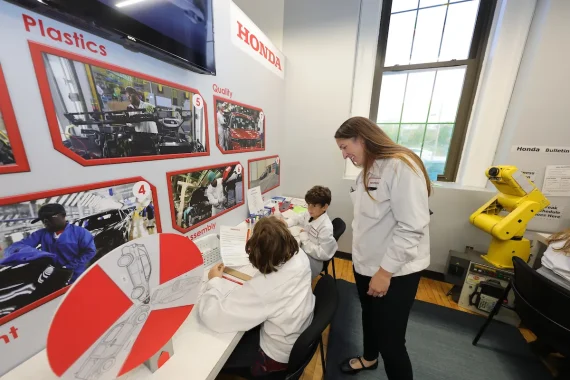Honda Issues 2017 North American Environmental Report
MARYSVILLE, Ohio (September 27, 2017) – Honda has released its 2017 North American Environmental Report (NAER) detailing the company’s environmental activities in North America, and disclosing the results of its efforts over the last fiscal year.
The NAER illustrates Honda’s Environmental Vision as well as its approach to managing environmental efforts throughout the company. The 51-page report also explains Honda’s views on public policies as they pertain to energy usage and development of alternate-fuel vehicles and technologies.
“Our efforts to minimize Honda’s environmental footprint extend beyond the products we make to all elements of our business,” said Toshiaki Mikoshiba, president & CEO of Honda North America, Inc. “As a mobility company, it is Honda’s responsibility to help address these issues with innovative thinking, technologies and product designs.”
The 2017 NAER is Honda’s 13th annual report on the environmental impact of its operations in North America, including the United States, Canada and Mexico, and covers the period from April 1, 2016 to March 31, 2017 (fiscal year 2017).
2017 North American Environmental Report Highlights:
Product Development
- In FY2017, Honda introduced more fuel-efficient Civic and CR-V models, its top two best-selling vehicles in North America and the first to utilize downsized Honda turbocharged engine technology, as well as the 2018 MDX Sport Hybrid sport-utility vehicle, the third Acura model to utilize three-motor hybrid technology.
- Honda also began the launch of its Clarity series of advanced environmental vehicles, starting with the Clarity Fuel Cell in late 2016. The Clarity series is at the forefront of Honda’s effort to grow its portfolio of electrified vehicles.
Purchasing
- Honda is also accounting for and helping to reduce CO2 emissions within its North American supply chain, where the company works with more than 550 OEM parts suppliers. In FY17, suppliers representing nearly 95 percent of the company’s total North American new-vehicle parts purchases reported CO2 emissions data to Honda.
- Honda improved its efficiency of OEM parts shipments throughout North America in FY17, reducing trailer deliveries and truck/rail travel by 19 percent and avoiding 1,154 metric tons of CO2, a 162 percent improvement from year-ago results.
Manufacturing
- The CO2e emissions intensity of automobile production in North America[i] in FY17 rose just two percent from a year ago despite all-time record levels of auto production, while total CO2e emissions from all North American manufacturing activities increased three percent in the same period.
- Honda has reduced per-auto waste-to-landfill from manufacturing by 93 percent and its total landfill waste by 87 percent from its baseline year of FY01[ii]
Sales and Service
- Honda was able to maintain waste sent to landfills from its 12 U.S. parts warehousing and distribution centers at the eight-year low 0.5 percent reached in FY2016.
- The CO2 emissions intensity of U.S. service parts shipments fell 5.9 percent from a year ago, and has been reduced 46.6 percent over the past six years.
- In FY17 more than 150 U.S Honda and Acura dealers received a Honda Environmental Award and combined for an annual reduction of 19,000 tons of CO2
.
Product In Use
- The unadjusted fleet-average fuel economy of Honda and Acura automobiles sold in the U.S.[iii] was 36.9 mpg in model year 2016 (MY16), outpacing the automobile industry average of 32.5 mpg by 4.4 mpg, or 13.5 percent.
- The unadjusted fleet average CO2 emissions of the company’s U.S. automobile fleet [iv] is 11.7 percent below (better than) the industry average.
- The fleet-average fuel economy of Honda motorcycles[v] is up 46.8 percent from the MY2000 baseline.
End-of-Life
- Honda recycled 9,181 nickel-metal hydride batteries in FY2017, helping to reduce the need to mine these rare-earth metals.
- Honda increased its e-waste, warranty and overstock parts diverted from landfill by 12 percent from FY2016, reaching its highest total since the company started the program.
Additional information on Honda’s environmental performance outside of North America can be found in Honda Motor Company’s Sustainability Report.
Honda’s Environmental Commitment
Based on its vision of “Blue Skies for our Children,” Honda is working to advance technologies that address society’s environmental and energy concerns. The company’s “Green Path” approach seeks to reduce or eliminate the use of substances of concern (SOCs) and scarce natural resources in the design of its vehicles, significantly reduce the CO2 intensity and water use of its manufacturing operations, continue to decrease CO2 emissions from the transportation of vehicles from its plants to dealers, and expand the involvement of U.S. Honda and Acura dealers as well as powersports, power equipment and marine dealers in its “Green Dealer” program.
These activities reinforce Honda’s goal to voluntarily reduce its total corporate CO2 emissions by 50 percent by the year 2050, compared to 2000 levels. In 2006, Honda was the first auto company to voluntarily and publicly commit to global reductions in its CO2 emissions.
i Total landfill waste includes all automobile, powersports, power equipment and aviation manufacturing operations in North America. Landfill waste at the Guadalajara, Mexico plant is allocated between automobile and motorcycle production based on sales value.
ii Energy used per auto encompasses all auto-related manufacturing activity, including automobile engines and transmissions produced in North America; it does not include power equipment, powersports and aviation manufacturing operations. Energy use at the Guadalajara, Mexico plant is allocated between automobile and motorcycle production based on sales value.
[iii] Source: U.S. Environmental Protection Agency: Light-Duty Automotive Technology, Carbon Dioxide Emissions, and Fuel Economy Trends: 1975 through 2015, published December 2015 (Table 4.5)
[iv] Source: U.S. Environmental Protection Agency: Light-Duty Automotive Technology, Carbon Dioxide Emissions, and Fuel Economy Trends: 1975 through 2015, published December 2015 (Table 4.3)
[v] Honda calculation using U.S. EPA exhaust emissions data. FY00-09 data are based on actual sales, while 2010 and later are based on production volumes. Some MY production is sold in later years (ex: a 2009 MY motorcycle that is sold new in 2011) and was omitted by the earlier method.

